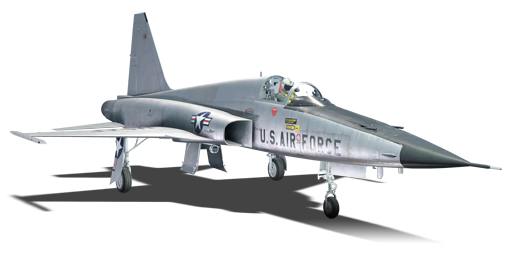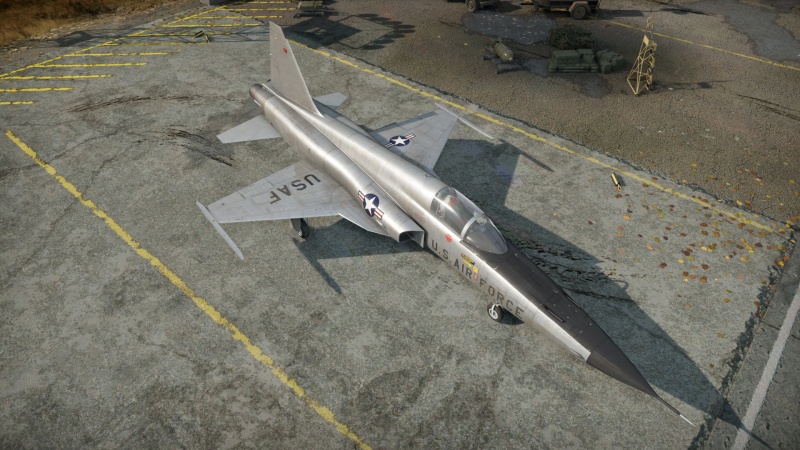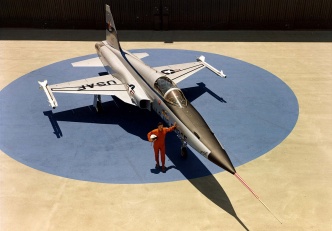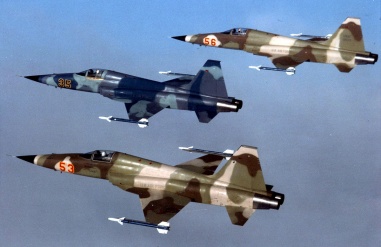F-5E
Contents
Description
The F-5E Tiger II is a rank VII American jet fighter with a battle rating of 11.3 (AB/SB) and 11.0 (RB). It was introduced in Update "Red Skies".
General info
Flight performance
Describe how the aircraft behaves in the air. Speed, manoeuvrability, acceleration and allowable loads - these are the most important characteristics of the vehicle.
| Characteristics | Max speed (km/h at 11,582 m) |
Max altitude (metres) |
Turn time (seconds) |
Rate of climb (metres/second) |
Take-off run (metres) | |||
|---|---|---|---|---|---|---|---|---|
| AB | RB | AB | RB | AB | RB | |||
| Stock | 1,756 | 1,746 | 15240 | 26.2 | 27.2 | 129.9 | 115.5 | 850 |
| Upgraded | ___ | 1,777 | __._ | 26.0 | __._ | 149.1 | ||
Details
| Features | |||||
|---|---|---|---|---|---|
| Combat flaps | Take-off flaps | Landing flaps | Air brakes | Arrestor gear | Drogue chute |
| ✓ | ✓ | ✓ | ✓ | ✓ | ✓ |
| Limits | ||||||
|---|---|---|---|---|---|---|
| Wings (km/h) | Gear (km/h) | Flaps (km/h) | Max Static G | |||
| Combat | Take-off | Landing | + | - | ||
| 0 | 482 | 1,018 | 470 | 463 | ~11 | ~5 |
| Optimal velocities (km/h) | |||
|---|---|---|---|
| Ailerons | Rudder | Elevators | Radiator |
| < 680 | < 750 | < 700 | N/A |
Engine performance
| Engine | Aircraft mass | ||||||
|---|---|---|---|---|---|---|---|
| Engine name | Number | Basic mass | Wing loading (full fuel) | ||||
| General Electric J85-GE-21A | 2 | 4,825 kg | 395 kg/m2 | ||||
| Engine characteristics | Mass with fuel (no weapons load) | Max Takeoff Weight | |||||
| Weight (each) | Type | 11m fuel | 20m fuel | 30m fuel | 38m fuel | ||
| 303 kg | Afterburning axial-flow turbojet | 5,423 kg | 5,861 kg | 6,379 kg | 6,820 kg | _,___ kg | |
| Maximum engine thrust @ 0 m (RB/SB) | Thrust to weight ratio @ 0 m (WEP) | ||||||
| Condition | 100% | WEP | 11m fuel | 20m fuel | 30m fuel | 38m fuel | MTOW |
| Stationary | 1,480 kgf | 2,220 kgf | 0.82 | 0.76 | 0.70 | 0.65 | _.__ |
| Optimal | 1,554 kgf (1,400 km/h) |
2,908 kgf (1,400 km/h) |
1.07 | 0.99 | 0.91 | 0.85 | _.__ |
Survivability and armour
Examine the survivability of the aircraft. Note how vulnerable the structure is and how secure the pilot is, whether the fuel tanks are armoured, etc. Describe the armour, if there is any, and also mention the vulnerability of other critical aircraft systems.
Modifications and economy
Armaments
Offensive armament
The F-5E is armed with:
- 2 x 20 mm M39A3 cannons, nose-mounted (280 rpg = 560 total)
Suspended armament
The F-5E can be outfitted with the following ordnance:
- Without load
- 2 x AIM-9B Sidewinder missiles
- 5 x 750 lb M117 cone 45 bombs (3,750 lb total)
- 5 x 500 lb LDGP Mk 82 bombs (2,500 lb total)
- 3 x 1,000 lb LDGP Mk 83 bombs (3,000 lb total)
- 1 x 2,000 lb LDGP Mk 84 bomb (2,000 lb total)
- 76 x FFAR Mighty Mouse rockets
- 8 x Zuni Mk32 Mod 0 ATAP rockets
- 4 x AGM-65B missiles
- 1 x 30 mm GAU-13/A cannon (353 rpg)
- 2 x AIM-9E Sidewinder missiles
- 2 x AIM-9E Sidewinder missiles + 5 x 500 lb LDGP Mk 82 bombs (2,500 lb total)
- 2 x AIM-9E Sidewinder missiles + 5 x 750 lb M117 cone 45 bombs (3,750 lb total)
- 2 x AIM-9E Sidewinder missiles + 3 x 1,000 lb LDGP Mk 83 bombs (3,000 lb total)
- 2 x AIM-9E Sidewinder missiles + 1 x 2,000 lb LDGP Mk 84 bomb (2,000 lb total)
- 2 x AIM-9E Sidewinder missiles + 76 x FFAR Mighty Mouse rockets
- 2 x AIM-9E Sidewinder missiles + 76 x FFAR Mighty Mouse rockets + 1 x 750 lb M117 cone 45 bomb (750 lb total)
- 2 x AIM-9E Sidewinder missiles + 38 x FFAR Mighty Mouse rockets + 3 x 750 lb M117 cone 45 bombs (2,250 lb total)
- 2 x AIM-9E Sidewinder missiles + 76 x FFAR Mighty Mouse rockets + 1 x 1,000 lb LDGP Mk 83 bomb (1,000 lb total)
- 2 x AIM-9E Sidewinder missiles + 8 x Zuni Mk32 Mod 0 ATAP rockets
- 2 x AIM-9E Sidewinder missiles + 8 x Zuni Mk32 Mod 0 ATAP rockets + 38 x FFAR Mighty Mouse rockets
- 2 x AIM-9E Sidewinder missiles + 8 x Zuni Mk32 Mod 0 ATAP rockets + 3 x 500 lb LDGP Mk 82 bombs (1,500 lb total)
- 2 x AIM-9E Sidewinder missiles + 8 x Zuni Mk32 Mod 0 ATAP rockets + 1 x 1,000 lb LDGP Mk 83 bomb (1,000 lb total)
- 2 x AIM-9E Sidewinder missiles + 8 x Zuni Mk32 Mod 0 ATAP rockets + 3 x 750 lb M117 cone 45 bombs (2,250 lb total)
- 2 x AIM-9E Sidewinder missiles + 4 x AGM-65B missiles
- 2 x AIM-9E Sidewinder missiles + 1 x 30 mm GAU-13/A cannon (353 rpg)
- 2 x AIM-9J Sidewinder missiles
- 2 x AIM-9J Sidewinder missiles + 5 x 500 lb LDGP Mk 82 bombs (2,500 lb total)
- 2 x AIM-9J Sidewinder missiles + 5 x 750 lb M117 cone 45 bombs (3,750 lb total)
- 2 x AIM-9J Sidewinder missiles + 3 x 1,000 lb LDGP Mk 83 bombs (3,000 lb total)
- 2 x AIM-9J Sidewinder missiles + 1 x 2,000 lb LDGP Mk 84 bomb (2,000 lb total)
- 2 x AIM-9J Sidewinder missiles + 76 x FFAR Mighty Mouse rockets
- 2 x AIM-9J Sidewinder missiles + 76 x FFAR Mighty Mouse rockets + 1 x 750 lb M117 cone 45 bomb (750 lb total)
- 2 x AIM-9J Sidewinder missiles + 38 x FFAR Mighty Mouse rockets + 3 x 750 lb M117 cone 45 bombs (2,250 lb total)
- 2 x AIM-9J Sidewinder missiles + 76 x FFAR Mighty Mouse rockets + 1 x 1,000 lb LDGP Mk 83 bomb (1,000 lb total)
- 2 x AIM-9J Sidewinder missiles + 8 x Zuni Mk32 Mod 0 ATAP rockets
- 2 x AIM-9J Sidewinder missiles + 8 x Zuni Mk32 Mod 0 ATAP rockets + 38 x FFAR Mighty Mouse rockets
- 2 x AIM-9J Sidewinder missiles + 8 x Zuni Mk32 Mod 0 ATAP rockets + 3 x 500 lb LDGP Mk 82 bombs (1,500 lb total)
- 2 x AIM-9J Sidewinder missiles + 8 x Zuni Mk32 Mod 0 ATAP rockets + 1 x 1,000 lb LDGP Mk 83 bomb (1,000 lb total)
- 2 x AIM-9J Sidewinder missiles + 8 x Zuni Mk32 Mod 0 ATAP rockets + 3 x 750 lb M117 cone 45 bombs (2,250 lb total)
- 2 x AIM-9J Sidewinder missiles + 4 x AGM-65B missiles
- 2 x AIM-9J Sidewinder missiles + 1 x 30 mm GAU-13/A cannon (353 rpg)
Usage in battles
Describe the tactics of playing in the aircraft, the features of using aircraft in a team and advice on tactics. Refrain from creating a "guide" - do not impose a single point of view, but instead, give the reader food for thought. Examine the most dangerous enemies and give recommendations on fighting them. If necessary, note the specifics of the game in different modes (AB, RB, SB).
Pros and cons
Pros:
- Great manoeuvrability
- An almost overwhelming selection of air-to-ground armaments, including Bullpup and Maverick air-to-ground missiles
- Generous ammunition capacity for guns
- Small target
- Efficient afterburner allows the use of lower fuel reserves, improving performance
Cons:
- Low top speed
- Can only carry a maximum of two air-to-air missiles
- No ballistic computer
History
In the late 1960s, Northrop realized that by using an improved version of the General Electric J85 engine with more maximum thrust, the flight performance of the N-156 fighter (F-5 Freedom Fighter) could be improved a lot. During the test, the new J85-GE-21 engine was approved that it could produce almost 23% more thrust than the earlier J85-GE-13 engine used by early produced F-5A/B Freedom Fighter, F-5C Skoshi Tiger and T-38 Talon, which was 5,000 pounds maximum thrust in afterburner mode and 3,500 pounds thrust in military mode.
As a result, the sixth production F-5B trainer was chosen to be modified with two new J85-GE-21 engines at Edwards AFB during the summer of 1969, and this upgraded Freedom Fighter with J85-GE-21 engines was called F-5-21 at that time. Overall, the new J85-GE-21 engine's weight was 100 lbs less than J85-GE-13 engine, the length of J85-GE-21 engine was 7 inches longer than J85-GE-13 engine, and an additional stage was added to the front of the J85-GE-13's previous eight-stage compressor to provide extra power, though the single rotor structure was retained, apart from that, two auxiliary intake doors were added to the fuselage above the wing trailing edge (one on each side of fuselage) to provide additional air to the engines for added thrust during take-off and low-speed flight. In Autumn of 1969, USAF decided to hold a new competition to select a new international fighter for Allied countries, and Northrop's F-5-21 program was announced the winner of new international fighter on 20th November 1970. Northrop received the contract from USAF for the further development of F-5E fighter on 8th December 1970. In January 1971, USAF changed the new F-5 fighter's designation from F-5-21 to F-5E, and the latter was named Tiger II in memory of the previous Skoshi Tiger Combat Evaluation program in Vietnam.
As for the airborne avionics system, a Central Air Data Computer was introduced on the new F-5E Tiger II, it could convert raw air data inputs into computed output, and transmit the results to other airborne electrical equipment such as Lead Computing Optical Sight System (LCOSS) and Stability Augmenter System. The new AN/ASG-29 LCOSS replaced the analogue fixed optical sight used by F-5A Freedom Fighter and F-5C Skoshi Tiger, which consisted a gyro lead computer (GLC) unit and an optical display unit (ODU), also an AIM-9 Sidewinder missile select switch was provided to select the appropriate missile launch envelope program stored in the GLC, and the ODU contained sight controls, a mirror drive assembly, and a combing glass which reflected the aiming reticle. Late production F-5Es changed the original AN/ASG-29 LCOSS to the new AN/ASG-31 LCOSS. The most important equipment of the F-5E was the new AN/APQ-153 multi-mode, forward-looking, X-band pulse, Search and Fire Control Radar, which could provide air-to-air search, range, and track information for use in Air-to-Air gunnery and missile launch, it formed the F-5E fighter's Fire Control System together with LCOSS unit, also the late production version of F-5E used AN/APQ-159 (V) 3 search and fire control radar instead of the previous AN/APQ-153 radar.
As for the aerodynamic design, in order to increase the manoeuvrability of F-5E, Northrop decided to increase the total area of Leading Edge Extensions (LEX) sections which were 2.75 times as large as that on the F-5A Freedom Fighter, also the wing area was more than 9% greater than that of F-5A Freedom Fighter, this improvement helped to increase lift and CL max (Coefficient of Lift) in high angle attack situations, also it could improve take-off and landing performance of F-5E too. The CL max of F-5E was increased to 1.4 compared with slightly lower than 1.2 for the F-5A Freedom Fighter, and the maximum lift-drag ratio at subsonic cruise speed was 10.
Thanks to the increased maximum power of new engine, the maximum level flight speed of F-5E was increased from Mach 1.4 to Mach 1.6, the maximum climb rate at sea level was also increased to more than 189 m/s, the empty weight was increased from 3,600 kg to 4,300 kg, and the maximum take off weight was increased to 9,800 kg, also the maximum internal fuel capability of F-5E was increased from 3,790 pounds to 4,536 pounds.
On 10th August 1972, the first F-5E completed its first flight at Edwards AFB. By March 1973, six F-5Es comprised the test force. One interesting fact was that during these flight tests at Edwards AFB, at least one F-5E fighter was painted with Imperial Iranian Air Force (IIAF) desert camouflage because at that time Iranian government was still willing to buy American military equipment. The Saudi Arabian Air Force decided to buy several F-5E and F-5F in 1976, which the program was named Peace Hawk IV, as the Saudi Arabian Air Force wanted to add the AGM-65 Maverick air-to-ground missile firing ability and Radar Warning Receiver equipment on their F-5 fighters, F-5E 71-1418 was chosen to conduct the test flights with AGM-65 Maverick air-to-ground missiles, also F-5E 75-00462 was chosen to test the new Chaff/Flare dispenser and AGM-65 Maverick air-to-ground missiles too. Except for Saudi Arabia and Iran, many other third-world countries such as Brazil, Kenya, and Malaysia became the customer of F-5 fighters, and the total number of countries and regions who received F-5Es was 37. Though the Imperial Iranian Air Force (IIAF) was changed to Islamic Republic of Iran Air Force (IRIAF) as a result of the coup in 1979, but during the Iran-Iraq war in 1980s, many former Imperial Iranian Air Force pilots who were trained by the US decided to join the battle against Iraq with the name of Islamic Republic of Iran Air Force after they were released by the government, even one time a F-5E of IRIAF successfully shot down a MiG-25 Foxbat interceptor of Iraq Air Force, the total air-to-air kills made by F-5 fighters of IRIAF was 23.
By late November 1986, the F-5E/F production line in California was finally shut down after it completed the last seven aircraft on the contract. Northrop built 2,603 F-5 fighters in total including 1,399 E and F models (793 F-5E and 146 F-5F according to some sources). The first unit of USAF equipped with F-5Es was the 425th Tactical Fighter Training Squadron (TFTS) at Williams AFB, which was responsible for the majority of the training of customer nation air and ground crew, they used F-5Es until June 1989, 1,499 students around the world were graduated from the 425th Tactical Fighter Training Squadron (TFTS). Apart from that, Imperial Iranian Air Force started to receive their F-5Es in 1974, but as the war situation of South Vietnam became worse, American decided to divert 18 F-5Es from the later Iranian order to support the Republic of Vietnam Air Force.
As a result, a total of 55 F-5Es were transported by the USA to South Vietnam before they lost the war on 30th April 1975. Except for battle damage and loss, about 27 F-5E fighters and 60-87 F-5A/B fighters that hadn't escaped to Thailand were captured by the North Vietnamese army after the defeat of South Vietnam. Through Vietnamese government decided to retain a small number of F-5 fighters and used them during the invasion of Cambodia, and they also sent some of the F-5 fighters to the Soviet Union. At first, the Soviet aircraft engineers didn't show much interest in the F-5Es because of the low thrust of the J85 engine, and they still believed that their fighters were much better than Western products. According to the estimation report of F-5E written by the Soviet engineers, they even thought that F-5E's level acceleration performance was only as slow as a piston fighter, also the estimated rate of climb at sea level was only 160 m/s. As a comparison, the true rate of climb of F-5A Freedom Fighter was 189 m/s.
Therefore, they thought that using the latest MiG-23 fighters against F-5E fighters was really bullying, so they decided to let the MiG-21bis fighter, which entered into service in 1972, conduct simulated air combat with a captured F-5E. The final result of that simulated air combat was beyond everyone's expectations: no matter what combat manoeuvre the MiG-21bis fighter did during the test, it couldn't avoid the fate of being shot down by the F-5E! The frustrated Soviet aircraft engineers decided to let their most advanced MiG-23M fighter at that time teach the F-5E fighter a lesson, but the result was almost the same: though the MiG-23M fighter could win in Beyond Visual Range engagements because of its R-23R medium-range semi-active radar-guided missile, however, the F-5E fighter could always maintain at the six o'clock position of MiG-23M fighter through various air combat manoeuvres. At last, the Soviet Union officially claimed that their aircraft was fully capable of competing with the most advanced fighter in the West at the time, but only the Soviet pilots knew that their nightmare would continue until today.
Back in 1972, the USAF realised the need for dissimilar aircraft combat training, and they began to use T-38 Talon trainers as an aggressor aircraft at Nellis AFB, Nevada. Although the USAF wanted the more desirable F-5E jets to act as the aggressor's aircraft, the F-5Es produced at the time were prioritized to South Vietnam to save the situation. After the Saigon government finally fell in 1975, many F-5Es including those former Republic of Vietnam Air Force's planes that escaped to Thailand successfully were transported to those aggressor squadrons of the USAF, apart from their homeland, the USAF also established some aggressor squadrons in England and the Philippines to train with other fighter squadrons overseas. As for the US Navy, they also realized the need for dissimilar aircraft combat training, even earlier than the Air Force. The famous Top Gun program was first established in 1969, initially with A-4 Skyhawk, but later it was changed to T-38 Talon and F-5E. In the 1980s, the U.S Navy introduced the F-16N Fighting Falcon and Israel F-21A Kfir as the new aggressor aircraft, therefore, the use of F-5E waned. In 2009, Northrop Grumman delivered the last 44 ex-Swiss Air Force F-5E to the US Navy after modification for use as aggressor aircraft, these 41 single seat fighters and three fighters modified from F-5E and F-5F were renamed F-5N by US Navy (one interesting fact was that in 1965, Northrop also tested a modified F-5A 63-8421 fighter which was equipped with two new J85-GE-15 engine, and this aircraft was initially named F-5N too, the N referred to Northrop), these aircraft were served in VFC-13 and VFC-111 aggressor squadrons in Nevada and Florida.
Media
Excellent additions to the article would be video guides, screenshots from the game, and photos.
See also
Links to the articles on the War Thunder Wiki that you think will be useful for the reader, for example:
- reference to the series of the aircraft;
- links to approximate analogues of other nations and research trees.
External links
| Northrop Corporation | |
|---|---|
| Fighters | P-61A-11 · P-61C-1 |
| Jet fighters | F-89B · F-89D |
| F-5A · F-5C · F-5E | |
| F-20A | |
| Export | ␗F-5A · ▄F-5E FCU |
| USA jet aircraft | |
|---|---|
| Fighters | |
| F9F | F9F-2 · F9F-5 · F9F-8 |
| F-80 | F-80A-5 · F-80C-10 |
| F-84 | F-84B-26 · F-84F · F-84G-21-RE |
| F-86 | F-86A-5 · F-86F-25 · F-86F-2 · F-86F-35 |
| F-89 | F-89B · F-89D |
| F-100 | F-100D |
| F-104 | F-104A · F-104C |
| F-4 | F-4C Phantom II · F-4E Phantom II · F-4J Phantom II · F-4S Phantom II |
| F-5 | F-5A · F-5C · F-5E · F-20A |
| F-8 | F8U-2 · F-8E |
| F-14 | F-14A Early · ▄F-14A IRIAF · F-14B |
| F-15 | F-15A · F-15C MSIP II · F-15E |
| F-16 | F-16A · F-16A ADF · F-16C |
| Other | P-59A · F2H-2 · F3D-1 · F3H-2 · F4D-1 · F11F-1 |
| Strike Aircraft | |
| FJ-4 | FJ-4B · FJ-4B VMF-232 |
| A-4 | A-4B · A-4E Early |
| A-7 | A-7D · A-7E · A-7K |
| AV-8 | AV-8A · AV-8C · AV-8B Plus · AV-8B (NA) |
| A-10 | A-10A · A-10A Late · A-10C |
| F-111 | F-111A · F-111F |
| Other | A-6E TRAM · F-105D · F-117 |
| Bombers | |
| B-57 | B-57A · B-57B |







